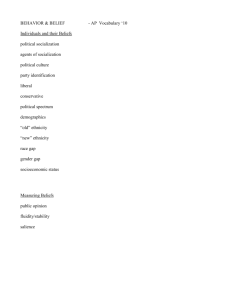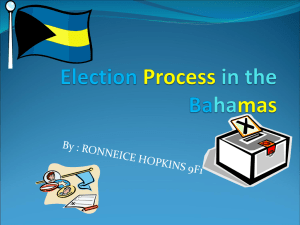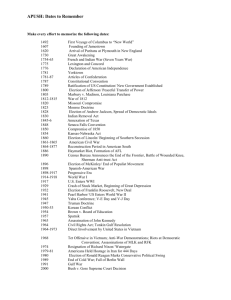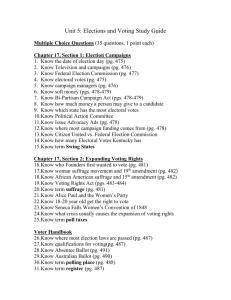here - Moritz College of Law
advertisement
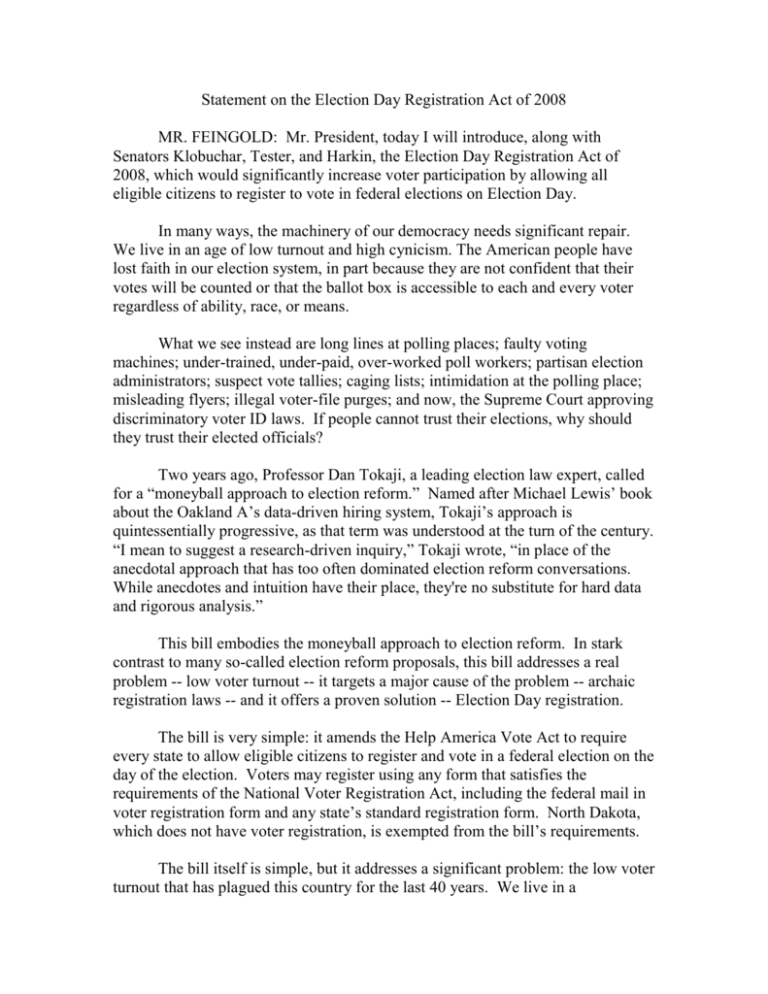
Statement on the Election Day Registration Act of 2008 MR. FEINGOLD: Mr. President, today I will introduce, along with Senators Klobuchar, Tester, and Harkin, the Election Day Registration Act of 2008, which would significantly increase voter participation by allowing all eligible citizens to register to vote in federal elections on Election Day. In many ways, the machinery of our democracy needs significant repair. We live in an age of low turnout and high cynicism. The American people have lost faith in our election system, in part because they are not confident that their votes will be counted or that the ballot box is accessible to each and every voter regardless of ability, race, or means. What we see instead are long lines at polling places; faulty voting machines; under-trained, under-paid, over-worked poll workers; partisan election administrators; suspect vote tallies; caging lists; intimidation at the polling place; misleading flyers; illegal voter-file purges; and now, the Supreme Court approving discriminatory voter ID laws. If people cannot trust their elections, why should they trust their elected officials? Two years ago, Professor Dan Tokaji, a leading election law expert, called for a “moneyball approach to election reform.” Named after Michael Lewis’ book about the Oakland A’s data-driven hiring system, Tokaji’s approach is quintessentially progressive, as that term was understood at the turn of the century. “I mean to suggest a research-driven inquiry,” Tokaji wrote, “in place of the anecdotal approach that has too often dominated election reform conversations. While anecdotes and intuition have their place, they're no substitute for hard data and rigorous analysis.” This bill embodies the moneyball approach to election reform. In stark contrast to many so-called election reform proposals, this bill addresses a real problem -- low voter turnout -- it targets a major cause of the problem -- archaic registration laws -- and it offers a proven solution -- Election Day registration. The bill is very simple: it amends the Help America Vote Act to require every state to allow eligible citizens to register and vote in a federal election on the day of the election. Voters may register using any form that satisfies the requirements of the National Voter Registration Act, including the federal mail in voter registration form and any state’s standard registration form. North Dakota, which does not have voter registration, is exempted from the bill’s requirements. The bill itself is simple, but it addresses a significant problem: the low voter turnout that has plagued this country for the last 40 years. We live in a participatory democracy, where our government derives its power from the consent of the governed, a consent embodied in the people’s exercise of their fundamental right to vote. It is self evident that a participatory democracy depends on participation. This may be a government of the people, Mr. President, but the people are not voting. Since 1968, American political participation has hovered around 50% for presidential elections and 40% for congressional elections. Even in 2004, a record-breaking year, turnout was only 55 percent of the voting age population. The United States may be the only established democracy where the fact that a little under half of the electorate stayed home is considered cause for celebration. In fact, our predecessors in the Senate would be surprised to find us celebrating such low turnout: a 1974 report by the Senate Committee on the Post Office and Civil Service bemoaned the “shocking” drop in turnout in the 1972 election. And what was the number that so troubled the Committee? Fifty-five percent. The report went on: “[i]t is the Committee’s conviction that our disquieting record of voter participation is in large part due to the hodgepodge of registration barriers put in the way of the voter. Such obstacles have little, if anything, to recommend them. At best, current registration laws in the various states are outmoded and simply inappropriate for a highly mobile population. At worst, registration laws can be construed as a deliberate effort to disenfranchise voters who desperately need entry into the decision-making processes of our country.” What a shame, Mr. President, that the Committee’s findings are still valid. Our archaic registration laws have been reformed, but they are still archaic. We have passed a number of important bills designed to combat low turnout, but turnout is still low. America is even more mobile than it was in 1974, and yet our registration laws are still out of touch with the reality that more than 40 million Americans move every year. Worst of all, our registration laws still fall especially hard on the young, the old, and the poor. We have long known that complicated voter registration requirements constitute one of the major barriers to voting. In fact, many states adopted voter registration in order to prevent certain segments of the population from voting. Alexander Keyssar, the preeminent scholar on the history right to vote in this country, writes that although “[r]egistration laws emerged in the nineteenth century as a means of keeping track of voters and preventing fraud; they also served – and were intended to serve – as a means of keeping African-American, working-class, immigrant, and poor voters from the polls.” 2 It is time for a fundamental change. A large body of research tells us that unnecessarily burdensome voter registration requirements are the single largest factor in preventing people from voting. Simply put, voter registration restrictions should not keep eligible Americans from exercising their right to vote. The solution to this problem is Election Day registration. Decades of empirical research confirm Election Day registration’s positive impact on turnout. As one academic paper states, “the evidence on whether EDR augments the electorate is remarkably clear and consistent. Studies finding positive and significant turnout impacts are too numerous to list.” Mr. President, studies indicate that Election Day registration alone increases turnout by roughly 5 to 10 percentage points. In general, states with Election Day registration boast voter turnout that is 10-12 percentage points higher than states that require voters to register before Election Day. Turnout in Minnesota and Wisconsin, which implemented Election Day registration over 35 years ago, has been especially high: in 2004, for example, 78% of eligible Minnesotans and 75% of eligible Wisconsinites went to the polls. Mr. President, the last time national voter turnout was above 70%, it was 1896, there were only 45 states, and the gold standard was the dominant campaign issue. Critics might worry about the possibility of fraud, but Election Day registration actually makes the registration process more secure. Voters registering on Election Day do so in the presence of an elections official who verifies the voter’s residency and identity on the spot. Mark Ritchie, Minnesota’s Secretary of State, points out that Election Day Registration “is much more secure because you have the person right in front of you—not a postcard in the mail. That is a no-brainer. We have 33 years of experience with this.” In contrast to most election reforms, the cost of Election Day Registration is negligible. A recent survey of 26 local elections officials in six EDR states found that “officials agreed that incidental expense of administering EDR is minimal.” In fact, Election Day Registration may actually result in a net savings because it significantly reduces the use of provisional ballots. Provisional ballots, which are required by the Help America Vote Act, are expensive to administer. The Congressional Budget Office estimates that provisional ballots cost state and local governments about $25 million a year. In some states the number of provisional ballots cast is surprisingly large. For example, in 2004, more than 4 percent of California’s registered voters cast provisional ballots – that’s 644,642 provisional ballots. In Ohio, 157,714 provisional ballots were cast, about 2% of all registered voters. 3 In contrast, in 2004 only 0.03% of voters in EDR states cast a provisional ballot. In Wisconsin, only 374 provisional ballots were cast. In Maine, only 95 provisional ballots were cast. In fact, only 952 provisional ballots were cast in all the EDR states combined in 2004. To be sure, this bill is no cure-all: it does not address long lines, deceptive flyers, and faulty voting machines. Other bills, good bills, address those issues. Mr. President, the bottom line is this: the Election Day Registration Act would substantially increase civic participation, improve the integrity of the electoral process, reduce election administration costs, and reaffirm that voting is a fundamental right. It has been proven effective by more than 30 years of successful implementation in Minnesota and Wisconsin and decades of empirical research. Election Day registration is good for voters, good for taxpayers, and good for democracy. I ask unanimous consent that the text of the legislation appear in the record following my statement. I yield the floor. 4
